The city of Yakutsk, in Russia, is nicknamed the coldest city in the world due to its extreme winter temperatures, often reaching -40 to -50 degrees Celsius. Located in eastern Siberia, it is at the heart of the hyperboreal continental climate where winter dominates almost all year round.

Yakutsk is located in eastern Russia, in the heart of Siberia, just 450 kilometers south of the Arctic Circle. Nestled between hills and far from the oceans, the city experiences an extreme continental climate. This isolated position prevents any temperate influence from the oceans. As a result, winters are incredibly cold and summers surprisingly warm. During the cold season, temperatures can easily drop below –40 °C, and even approach –50 °C. It’s safe to say that winter here is no joke.
The entire region of Yakutia rests on permafrost, soil that has been frozen permanently for thousands of years. This permafrost sometimes descends hundreds of meters underground and acts like a huge natural freezer, maintaining extremely low temperatures. As soon as the air cools down, this frozen soil directly releases its cold to the surface, thus preventing any real warming. This particular phenomenon amplifies extreme cold by making thawing periods rare and short. Because of this frozen ground, everything becomes complicated: building, installing pipelines, even burying the dead requires special techniques. In Yakutsk, buildings are constructed on stilts to prevent the heat from the buildings from thawing the ground, as thawing would cause serious damage. Therefore, permafrost is essential to understanding why this region has become one of the coldest on the planet.
Yakutsk experiences some of the most extreme winter temperatures on the planet. The thermometer regularly drops below -40°C, and in January, the coldest month, it often flirts with -50°C. The absolute record recorded in this city stands officially at -64.4°C, measured in February 1891. It makes you want to get a good down jacket, doesn't it? Even though these figures are almost mind-boggling, note that the feeling of cold is intensified by icy winds, which make prolonged outdoor activities even more difficult (if not impossible!).
In Yakutsk, adapting to the polar cold has become routine. As soon as the thermometer drops, the city slows down, but never really stops. People dress in thick traditional layers: fur-lined boots, parkas made from animal skins or modern insulating fibers, and fur-trimmed hoods protecting their faces and lungs. To go to work or do their shopping, most residents rely on specially prepared vehicles for temperatures below -40°C, equipped with special insulation, reinforced heating, and batteries adapted to extreme cold. Buildings rest on pilings deeply embedded in the permafrost to prevent the permanently frozen ground from melting under the heat of the structures and causing damage. The city also has particular systems for heated water supply and sewage to prevent any freezing of pipes that otherwise burst unexpectedly. In these conditions, people limit their time spent outdoors to the bare minimum when the cold is extreme. Schoolchildren often stay home when temperatures drop beyond a certain threshold (typically starting at -45°C); no one complains because everyone knows it is to avoid the risks of frostbite and hypothermia.
Yakutsk easily surpasses other well-known icy cities like Ulaanbaatar in Mongolia or Fairbanks in Alaska. For example, Ulaanbaatar regularly sees around -25°C in winter, which is very cold, it's true, but Yakutsk easily drops below -40°C, with even lower extremes. Even famously cold Canadian cities like Winnipeg or Yellowknife struggle to compete with the extreme cold of Yakutsk. In short, if you already find European or North American winter temperatures unbearable, Yakutsk would offer you a frosty experience on a whole different level.
Despite its extreme cold in winter, Yakutsk also experiences surprisingly warm summers with temperatures regularly exceeding 30°C, giving it one of the highest annual temperature ranges in the world.
In Yakutsk, the cold air is so intense in winter that simply throwing a cup of boiling water into the air causes it to immediately turn into ice crystals before even hitting the ground.
Yakutsk is home to the "Kingdom of Permafrost," a unique museum in the world entirely dug into permanent ice, showcasing exceptional ice sculptures and perfectly preserved prehistoric fossils.
During the coldest days, the residents of Yakutsk often leave their vehicle engines running all day to prevent them from completely freezing, which leads to an exceptional fuel consumption.
Yakutsk is much colder than cities like Anchorage (Alaska) or Reykjavik (Iceland). While in winter, Anchorage records average temperatures close to -10°C and Reykjavik around 0°C, Yakutsk has winter averages that can drop to -40°C or even lower, thus confirming its title as the coldest inhabited city on the planet.
Yes, despite its frigid winters, Yakutsk experiences surprisingly warm and short summers. The temperature in July can indeed exceed +30°C, allowing for a brief period of comfortable outdoor activities for the residents.
The residents of Yakutsk wear ultra-insulating clothing made of fur and special materials to combat extreme cold. Additionally, vehicles must be equipped with specific engine heating systems to prevent freezing. Houses are also extremely well insulated, thanks to special materials designed for these extremely low temperatures.
Permafrost is a layer of permanently frozen soil at depth, remaining frozen all year round. In Yakutsk, permafrost is ubiquitous and reaches depths of several hundred meters. It profoundly influences local architecture, requiring buildings to be constructed on stilts and significantly impacting the daily lives of the residents.
The coldest recorded temperature in Yakutsk is around -64.4°C. However, in winter, average temperatures commonly range between -40°C and -50°C, making this city truly extreme in terms of cold climate.

No one has answered this quiz yet, be the first!' :-)
Question 1/7